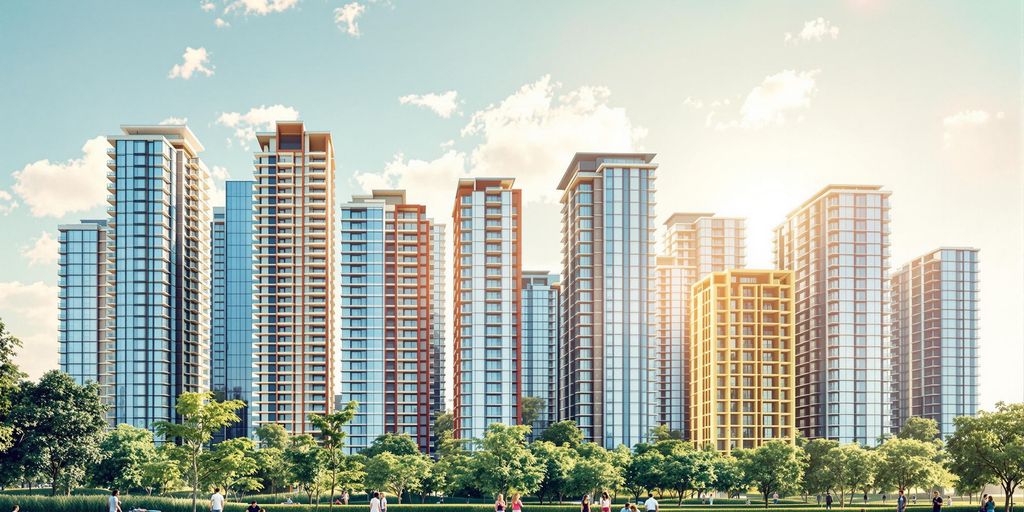Real estate is always changing. In 2025, we’re seeing some big shifts. From eco-friendly homes to virtual reality tours, the landscape is evolving. Home prices are climbing, and remote work is changing where people want to live. Tech-savvy homes are on the rise, and hybrid real estate models are becoming more common. Let’s dive into these trends and see what’s next for real estate in 2025.
Key Takeaways
- Sustainable living is more than a trend; it’s becoming a standard in real estate.
- Virtual reality is making home tours more accessible and efficient.
- Rising home prices are affecting first-time buyers and market dynamics.
- Remote work is shifting housing demands towards suburban areas.
- Tech-savvy homes are increasingly popular, with smart features in demand.
Sustainable Living in Real Estate
Eco-Friendly Home Features
In 2024, homebuyers are all about eco-friendly features. People are looking for homes that are not just comfortable, but also kind to the planet. Solar panels, energy-efficient windows, and smart thermostats are some of the top features buyers want. These features help reduce energy bills, which is a big win for homeowners and the environment. More and more, folks are choosing homes with these green features because they know it’s a smart investment for the future.
Green Building Practices
Green building practices are becoming the norm. Builders are using sustainable materials and methods to create homes that are both beautiful and environmentally friendly. Here are some practices that are gaining traction:
- Solar Panels: Harnessing the sun’s energy to power homes.
- Rainwater Harvesting: Collecting rainwater to reduce water usage and utility bills.
- Energy-Efficient Windows: Minimizing heat loss and gain, keeping homes comfortable year-round.
- Green Roofs: Adding greenery to rooftops to improve air quality and manage rainwater.
- Zero-Energy Homes: Homes that produce as much energy as they consume.
These practices not only help the environment but also attract buyers who are eager to live sustainably.
Energy Efficiency in Housing
Energy efficiency is at the heart of sustainable living. Homeowners are increasingly aware of their carbon footprint and want to reduce it. Upgrading insulation, using energy-efficient appliances, and installing LED lighting are just a few ways homes are becoming more energy-efficient.
As energy costs rise, energy-efficient homes are not just a trend—they’re a necessity. Homeowners save money and contribute to a healthier planet. It’s a win-win situation.
The push for energy efficiency in housing is part of a broader sustainable real estate trend that focuses on reducing long-term costs and minimizing environmental impacts. As more buyers look for these features, the real estate market is adapting quickly to meet demand.
The Rise of Virtual Reality in Real Estate

Virtual Tours for Buyers
Virtual reality (VR) is revolutionizing how buyers explore properties. Imagine being able to “walk” through a house without ever leaving your couch. This technology offers a life-like experience, making it easier for potential buyers to get a real feel of a property from anywhere in the world. No more spending hours traveling from one place to another. With VR, buyers can quickly decide which homes they want to visit in person, saving time and effort. This trend is expected to bring in $2.6 billion by 2025, highlighting its growing importance in the real estate market.
Augmented Reality Applications
Augmented reality (AR) is another game-changer in real estate. It allows buyers to visualize changes in a property before making any commitments. Want to see how a new couch would look in the living room? Or maybe how a different paint color would brighten up a space? AR makes it possible to “try before you buy,” enhancing the decision-making process. This technology is not just for buyers; sellers can also use AR to stage homes virtually, making them more appealing to potential buyers.
Impact on Real Estate Sales
The use of VR and AR is transforming real estate sales. These technologies make properties accessible to a wider audience, breaking geographical barriers. As a result, real estate agents can reach international buyers with ease. The immersive experience provided by VR and AR helps buyers feel more confident in their purchasing decisions, leading to quicker sales. In a competitive market, agents who embrace these technologies will likely have an edge over those who don’t.
Virtual and augmented reality are no longer just buzzwords in the tech industry. They are reshaping how we buy and sell homes, offering new opportunities and challenges for real estate professionals. Adapting to these changes is crucial for success in 2024 and beyond.
For more on how Virtual and Augmented Reality are transforming real estate, check out the latest trends and technologies impacting this dynamic industry.
Navigating Rising Home Prices
Impact on First-Time Buyers
Buying your first home is like trying to hit a moving target these days. Prices keep climbing, and it’s tough for newcomers to get a foot in the door. The cost of homes has been on the rise, with an average increase of 7.6% just since January 2024. For first-time buyers, this means having to save more for a down payment and potentially settling for less desirable locations. Many are turning to creative solutions like co-living arrangements or house hacking—where you buy a property and rent out part of it to help cover the mortgage. But even these strategies require careful planning and a bit of luck.
Home Equity Growth
While rising home prices can be a hurdle for buyers, they’re a boon for current homeowners. With prices going up, homeowners are seeing their equity grow significantly. In fact, the average homeowner in the U.S. experienced a 9.6% increase in equity last year, adding a collective $1.5 trillion. This growth in equity can provide homeowners with more financial flexibility, allowing them to invest in home improvements, pay off debt, or even purchase additional property. However, it’s crucial for homeowners to consider the potential tax implications and costs associated with tapping into this equity.
Market Cooling Trends
Despite the rising prices, there are signs that the market might be cooling off. In the first quarter of 2024, median housing prices actually saw a slight dip. This could be due to more homes coming onto the market as those with low-rate mortgages reach the end of their terms. Additionally, the “lock-in effect,” where homeowners with low mortgage rates choose not to sell, may be easing as more people decide to take advantage of their increased equity. This potential increase in supply could help balance the market, offering a bit of relief to prospective buyers. But, as always, it’s a waiting game to see how these trends will play out in the coming months.
The Influence of Remote Work on Real Estate

Shift to Suburban Living
Remote work has changed where people want to live. Many workers are moving away from crowded city centers to find more space and quieter environments. Suburban and rural areas are seeing a rise in popularity as folks look for affordable housing and a better quality of life. This shift has opened up new opportunities in real estate markets that were previously less competitive. Families are finding that they can get more for their money outside the big cities.
- Increased demand for suburban homes
- More space for home offices
- Better quality of life with less commuting
Impact on Commercial Spaces
The demand for commercial real estate is shifting. With fewer people needing to be in the office every day, companies are rethinking their space needs. Some businesses are downsizing, while others are transforming their offices into hybrid workspaces. This change means commercial real estate is adapting, with a focus on flexible spaces that can be easily reconfigured.
| Factor | Impact on Commercial Real Estate |
|---|---|
| Reduced office demand | Downsizing and subleasing of space |
| Hybrid work models | Conversion to flexible office layouts |
| Increased remote work | Less need for large office spaces |
Remote Work and Housing Demand
The ability to work from anywhere is affecting housing demand. People are prioritizing homes that offer comfort and functionality for remote work. Features like dedicated office spaces, high-speed internet, and quiet neighborhoods are becoming more desirable. As remote work becomes a long-term reality, these preferences are likely to shape the housing market significantly.
The shift to remote work has enabled families to relocate to more affordable areas for real estate purchases, significantly impacting the housing market. Explore more about this shift.
Overall, remote work is not just a temporary trend but a lasting change that is reshaping how and where we live and work.
Tech-Savvy Homes and Smart Living
Smart Home Features
In today’s world, smart homes are no longer a luxury but a standard expectation. Many Americans are willing to shell out extra bucks just to have those smart features. From voice-activated assistants that control your lights and thermostat to smart refrigerators that tell you when you’re out of milk, the convenience is unmatched. Imagine walking into a home where your favorite playlist starts as soon as you step through the door—it’s like living in the future. Smart homes are also about safety, offering systems that can alert you to intrusions or even let you see who’s at the door when you’re miles away.
Integration of IoT Devices
The Internet of Things (IoT) is weaving its way into the very fabric of our homes. Devices talk to each other, creating an environment that’s not just connected, but almost intuitive. Your smartwatch can communicate with your home security system, and your smartphone can adjust your home’s lighting based on your preferences. This interconnectedness offers a seamless living experience that tech enthusiasts crave. The more these devices integrate, the more they can tailor your living space to suit your lifestyle.
Security Systems in Modern Homes
With all this tech, security becomes a top priority. Modern homes are equipped with advanced security systems that are not just about keeping intruders out but also about keeping you informed. From cameras you can access remotely to sensors that detect unusual activity, these systems offer peace of mind. Plus, with features like facial recognition and biometric access, your home is not just secure—it’s smartly secure.
The future of home living is here, and it’s smarter than ever before. As technology continues to evolve, so will our homes, creating spaces that are not only efficient and safe but also incredibly personalized.
Hybrid Real Estate Models
Combining Online and Traditional Services
In 2024, real estate is shaking things up with hybrid models that mix the best of online and traditional services. It’s like getting the convenience of the internet with the personal touch of a face-to-face meeting. This means buyers can now browse listings online, check out virtual tours, and even close deals from their couch. But if they need that human connection, real estate agents are still there to help. This model is all about flexibility, letting clients choose how they want to buy or sell their homes.
Personalized Client Experiences
Hybrid models also mean more personalized experiences for clients. With the help of digital tools, clients can:
- Search for properties that match their specific needs.
- Attend virtual tours without leaving their homes.
- Get real-time updates about new listings.
And for those who prefer the traditional route, agents can offer in-person tours and consultations to provide that extra layer of support. It’s all about giving clients options and making the process as smooth as possible.
Future of Real Estate Transactions
Looking ahead, the future of real estate transactions is all about flexible and adaptable office spaces. These hybrid models are set to transform how deals are done, making transactions quicker and more secure. Expect to see more use of technology like blockchain for secure payments and smart contracts to automate processes. This shift not only speeds things up but also reduces the risk of fraud, making buying and selling homes a breeze.
As we move forward, the lines between online and offline real estate services will continue to blur, providing a more streamlined and efficient experience for everyone involved.
Affordable Housing Challenges
Impact of Interest Rates
Interest rates are a huge deal when it comes to buying a home. When they go up, your monthly payments do too, making it harder for people to afford a place. In 2024, interest rates have been pretty high, which isn’t great news for anyone looking to buy. Even if rates drop a bit, other costs like taxes and insurance premiums are still climbing, keeping the dream of owning a home out of reach for many.
Strategies for Middle-Class Buyers
Middle-class buyers are feeling the pinch, but there are ways to work around it. Here are some strategies:
- Look for First-Time Homebuyer Programs: These can offer lower down payments and better loan terms.
- Consider Multi-Generational Living: Sharing a home with family can help split costs.
- Explore House Hacking: Rent out part of your home to cover some mortgage payments.
Government Initiatives
Governments are trying to help, but it’s a slow process. They’re offering grants and subsidies to make housing more affordable. These initiatives are crucial, especially as the demand for affordable housing grows. The market for these homes is expected to hit $84.7 billion by 2031, showing just how big the need is.
With rising costs everywhere, affordable housing is more important than ever. It’s not just about having a roof over your head; it’s about creating a stable foundation for families to thrive.
Top Real Estate Markets to Watch
Emerging Markets in the Sunbelt
The Sunbelt region is buzzing with activity, making it a hotspot for real estate in 2024. Cities like Dallas and Tampa are leading the charge, thanks to their booming populations and vibrant economies. This area isn’t just about single-family homes; multifamily housing and commercial spaces are also seeing a surge. With the influx of new residents, these markets are ripe for investment. Keep an eye on Zillow’s list of the top 10 most popular housing markets for 2024, which includes several Sunbelt cities.
Investment Opportunities
Investors are flocking to areas that promise high returns and stability. The Sunbelt’s growth is a significant draw, but don’t overlook other promising spots. Cities like Austin continue to attract attention for their tech-driven economies and lifestyle appeal. There’s a diverse range of opportunities, from residential developments to commercial real estate ventures.
Market Dynamics in 2024
The real estate landscape is shifting, with new trends emerging as the year unfolds. Rising home prices are a double-edged sword, benefiting homeowners but challenging new buyers. However, the market is showing signs of cooling, with some regions experiencing a slight dip in prices. This dynamic environment requires investors and buyers to stay informed and adaptable. Expect fluctuations, but also opportunities for those ready to seize them.
The real estate market in 2024 is a mix of challenges and opportunities, driven by demographic shifts and economic changes. Staying informed and adaptable will be key to navigating this evolving landscape.
Conclusion
As we wrap up our look into the future of real estate in 2024, it’s clear that change is the only constant. From the rise of sustainable living spaces to the integration of virtual reality in property tours, the industry is evolving in exciting ways. Home prices are on the move, and tech-savvy homes are becoming the norm. Meanwhile, the shift to remote work is reshaping where people choose to live. For those in the real estate game, staying ahead means keeping an eye on these trends and being ready to adapt. It’s a dynamic time, and the opportunities are as vast as the challenges. So, whether you’re buying, selling, or just watching from the sidelines, 2024 promises to be a year full of surprises in the real estate world.
Frequently Asked Questions
What are eco-friendly home features?
Eco-friendly home features include solar panels, energy-efficient appliances, and rainwater collection systems. These features help reduce the environmental impact of a home.
How does virtual reality help in real estate?
Virtual reality allows potential buyers to take virtual tours of homes without having to visit them in person. This makes it easier to explore multiple properties quickly and conveniently.
Why are home prices rising?
Home prices are going up because there are more people wanting to buy homes than there are homes available. This high demand and low supply make prices increase.
How has remote work affected real estate?
Remote work has made many people move away from busy cities to quieter suburban areas. This shift has changed the demand for housing in different locations.
What are smart home features?
Smart home features include things like smart thermostats, security cameras, and voice-controlled lights. These make homes more convenient and energy-efficient.
What are hybrid real estate models?
Hybrid real estate models combine online services with traditional in-person help. This means buyers can use digital tools to find homes but also get help from real estate agents when needed.


